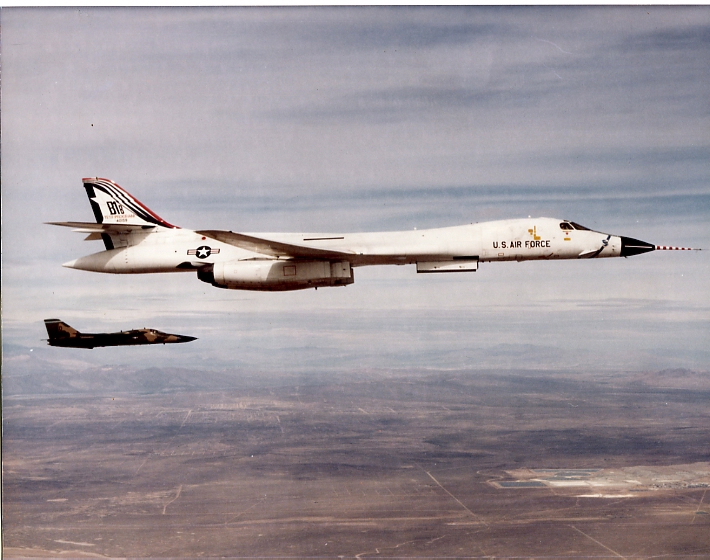Pretty Bird!

A very nice picture of B-1A Ship 2 flying over the High Desert of California.
A few things to note about this picture;
This is Ship 2 after coming out of it's modification phase. Fliht controls, weapons bays, engines, and so on were modified in a year-long program to as closely simulate what a B-model aircraft would do, so we could get a leg up on flight testing before a single B model had been built.
Note to the horrible paint scheme on the tail. Yuuuk. Rockwell did that for marketing value. They painted it over the weekend, we all went home Friday, came in Monday, and saw that mess on the tail. Up close, by the way, looks like a bunch of 5 year olds painted it. Annoying, since this is such a pretty airplane.
The candy-striped pitot probe on the nose of the airplane also should be noted: This was a speed and flight regime test aircraft, the airplane where the numbers ,like stall speeds, airspeed calibrations, etc. were discovered/validated on. To do this accurately you have to put your pitot/static/Angle of Attack sensors well away from the fuselage or wing, since airflow around those body members will disturb the accuracy of your readings. Those sensors were mounted at the end of the candy-striped boom, well away from the airplane. Of course this meant that Ship 2 had no radar in the nose, it didn't do any of the TFR and other radar ops testing (that was 3 & 4).
Also note no defensive antennas on the wing glove area, those were added on Ship 4 and later. Same with the tail, there was no tail warning radar or defensive avionics in the back on ships 1 & 2, just a big empty tailcone. No, we didn't keep beer in there. Aircrews were know, though, to scrape that cone on the runway, at least twice.
Wepons bay door open, look out below!
The other aircraft is an F-111. We generally used one (as I recall) F-111 at a time as a chase plane on test flights, with other aircraft used as needed. The B-1 program drew a lot of maintenance and flight crew folks from the F-111 force, since, well, they both have sweeping wings, they must be the same, right?
Aother thing you might be able to see: Look straight down from the R in Air Force on the forward fuselage. You might be able to see a slight bumb on the bottom of the aircraft. That is a faired camera pod. For weapons drop tests, there were camera in froont, behind (you might be able to see that) and inside the weapons bay to document, at high speed, the entire drop. This, by the way, was how the need for weapons bay spoilers in the B models was determined, the cameras caught a slight "float" as the weapons dropped from the bay through the very laminar flow across the belly of the aircraft, slightly delaying the exiting of the weapon from the aircraft (bad). We had retrofitted drop down spoilers (not yet deployed in this pic) to dirty that airflow and insure a clean weapon separation on ship 2 to test for the B model fleet. Since they were retrofits, by the way, they had to be removed anytime the launcher had to be removed from the weapons bay (like when switching from SRAMs to conventional weapons). Me & Doug held the record, 11 minutes for removal, 18 minutes for re-installation. Gary S. & Darwin were pretty good at it too, but Doug was quicker with a hammer (did I mention he was a crew chief?) so we won.